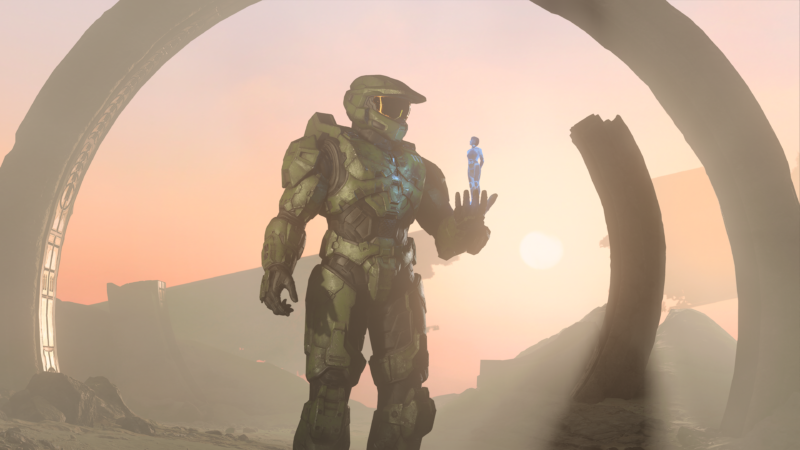
To be clear, I enjoyed my time with Halo Infinite's campaign. That's primarily because the game sees 343 finally nail its own Halo "voice," one whose mechanics, gunplay, and physics feel more rooted in the series' past than ever before. Meanwhile, 343 uses clever ideas to modernize and go beyond the foundation established by Bungie. And the game delivers story, dialogue, and sci-fi stakes where they count.
But there's no way to review this title without complaining about the game's launch state. Halo Infinite may reach new series heights, but its ambition tests the limits of the duct tape keeping the game together.
Before we begin, three housekeeping notes
First, this is a campaign-exclusive review. Xbox Game Studios has wisely split Halo Infinite into two discrete parts, and the online versus-multiplayer suite has been live as a free-to-play game since November 20. It's quite fun, and I'll have more to say about it in the near future. For this article's purposes, "Infinite" refers to the campaign launching on Steam, Windows 10, and Xbox consoles on Wednesday, December 8, not the versus modes.
Second, Ars Technica takes spoilers seriously, so I will avoid talking about significant plot points. I arguably spoil a few things about the game's progression to make critical points, though. If that's an issue for you, now's a good time to stop reading, or you can simply skip to the verdict at the very end of the story.
And third, Infinite is currently missing a massive feature: there's no co-op mode yet. 343 Industries opted to sacrifice the series' expected co-op functionality in order to meet a December 2021 launch deadline. Get the single-player done now; add co-op later. (Current estimate: May 2022.)
Demerit for not being cooperative
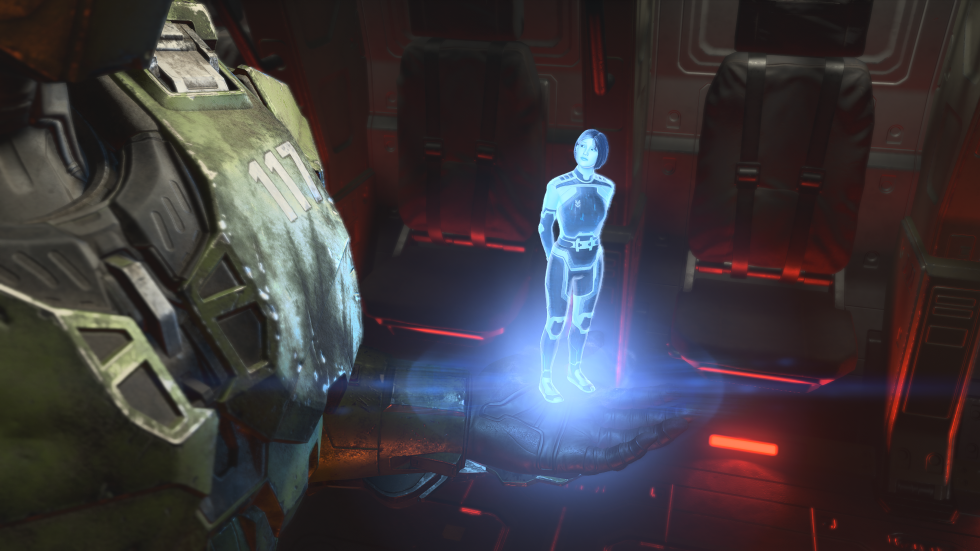
Having played the Infinite campaign to completion, I understand how this situation could have come to be. Progression and quest chains are now blended into an open-world structure, which means the game doesn't work like the menu-driven Halo games of old. I wonder if co-op will work as a drop-in, drop-out kind of game, with only the "primary" player advancing in terms of unlockables and progress. (I'll get to that later.)
Was nixing co-op the right call? Financially, for Microsoft, maybe. On a gameplay level, I couldn't stop thinking about co-op while playing Infinite alone. The game's best missions and combat include more reasons to invite squadmates and issue battlefield commands than any Halo game in the past, and 343 acknowledges this by giving you AI squadmates as an unlockable perk through the campaign.
If the absence of co-op is a dealbreaker for you—a likelihood reinforced by the past seven campaigns shipping with the feature—you should wait. Don't install the campaign. Even if you hate online shooters, I suggest grabbing the free-to-play versus-multiplayer suite, teaming up with friends, and playing together in Infinite's handy "versus bots" lobbies. You'll get all the game's new weapons and abilities, plus some very solid AI bots to square off against. The mode will tide you over much better than making someone watch you play the campaign by yourself.
“We’ll build a ring-shaped superweapon again!”
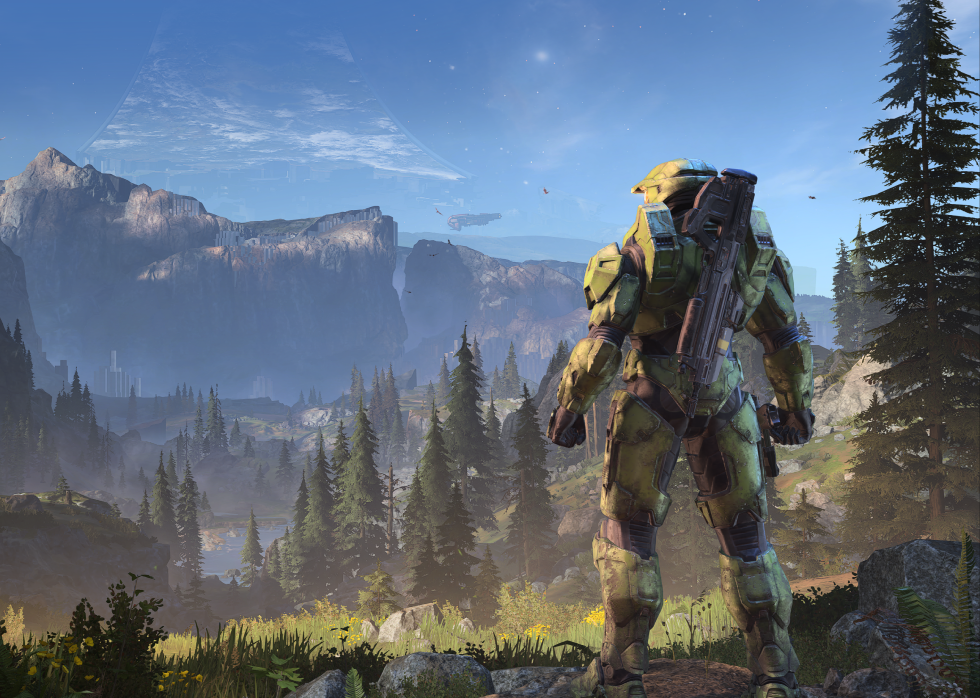
With that out of the way, I'll start with the good news.
Do you want a return to the series' meaty sci-fi plot stakes, bolstered by trippy scenes and solid acting? Do you want a massive landscape over which you can drive a rumbly, tumbly four-wheeler through an encampment of foes? After that, do you want to nimbly grapple-hook your way into a massive battle that rekindles your love for Halo? You'll find that stuff here.
Infinite follows the series' core tenets of providing excellent first-person gunplay, third-person driving, and a slew of familiar military and alien weapons. Unlike in 2015's Halo 5, we're back to controlling the character Master Chief the entire time, and he finds himself landing on an unfamiliar, supersized ring planet called Zeta Halo. It has been blasted and partially destroyed, and some very bad monsters have designs on putting it back together—and turning it into a human-killing superweapon.
That may sound like the Halo series is putting up its version of the Death Star—"we'll build a ring-shaped superweapon again!"—but the game differentiates its environments and plot beats enough to make Infinite's familiar premise work better in practice than on paper. More on that in a bit.
Ravagers, Skewers, and Heatwaves, oh my
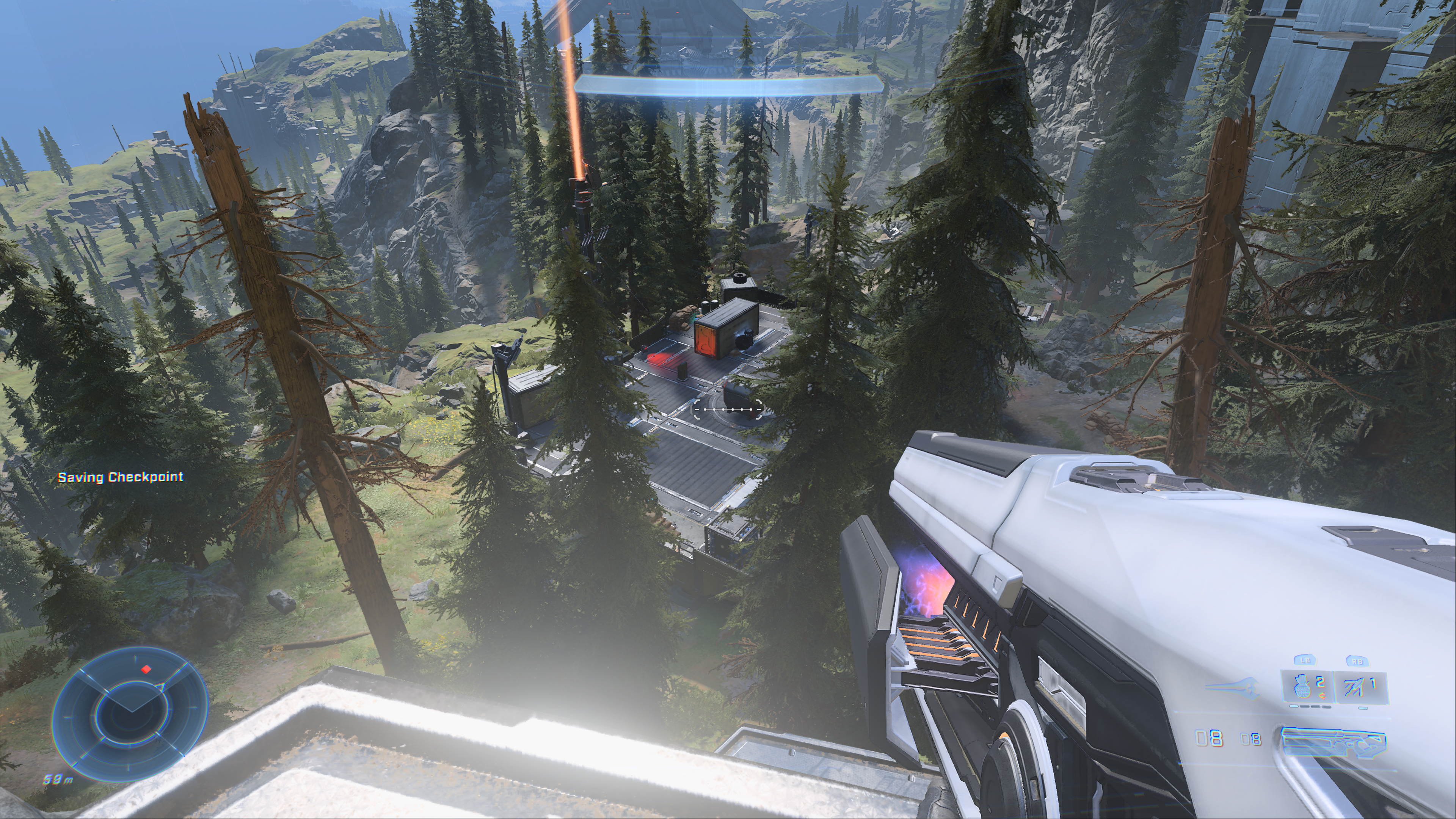 Shoot at an enemy encampment.
Shoot at an enemy encampment.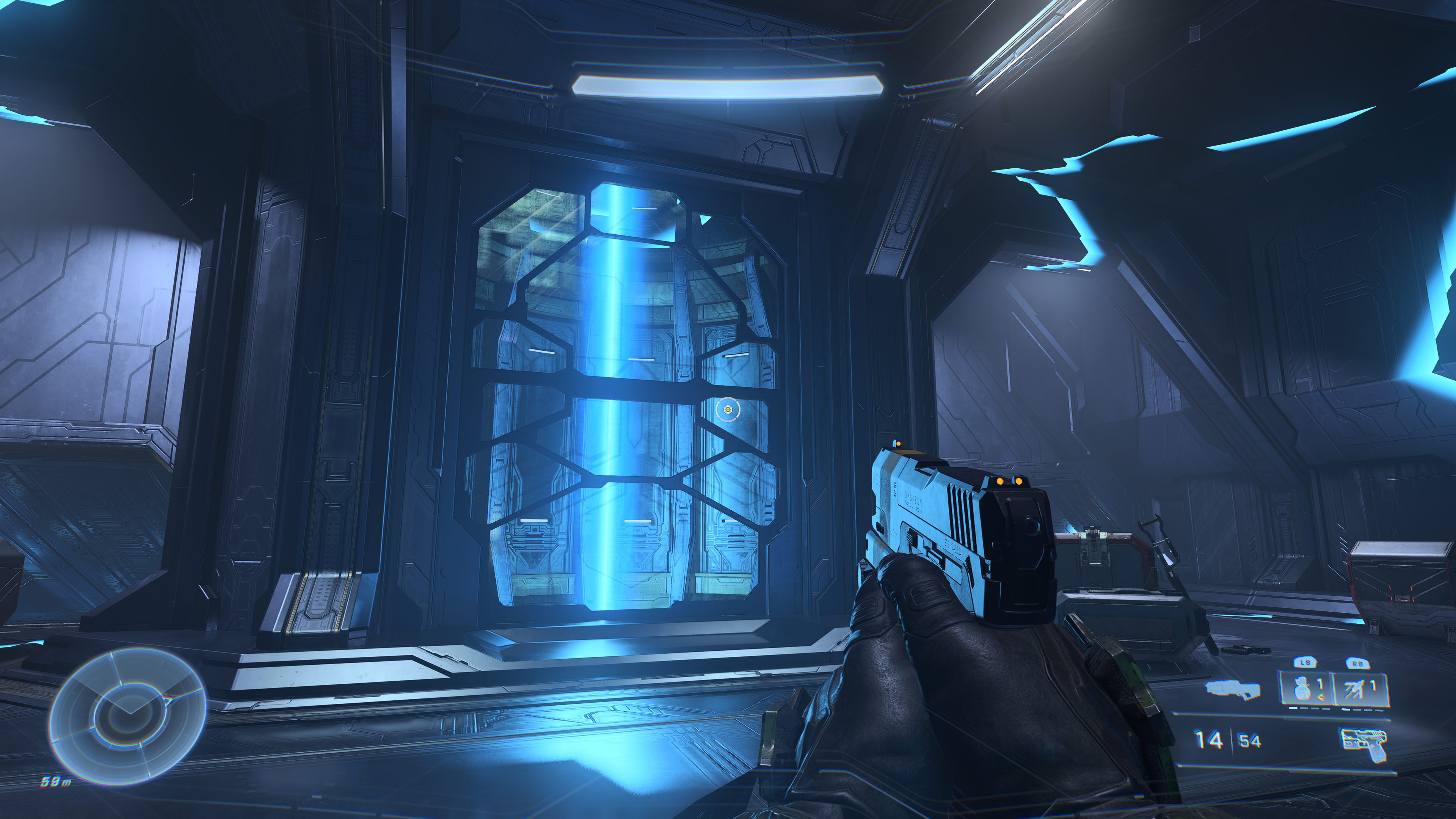 Shoot inside an enemy's base.
Shoot inside an enemy's base.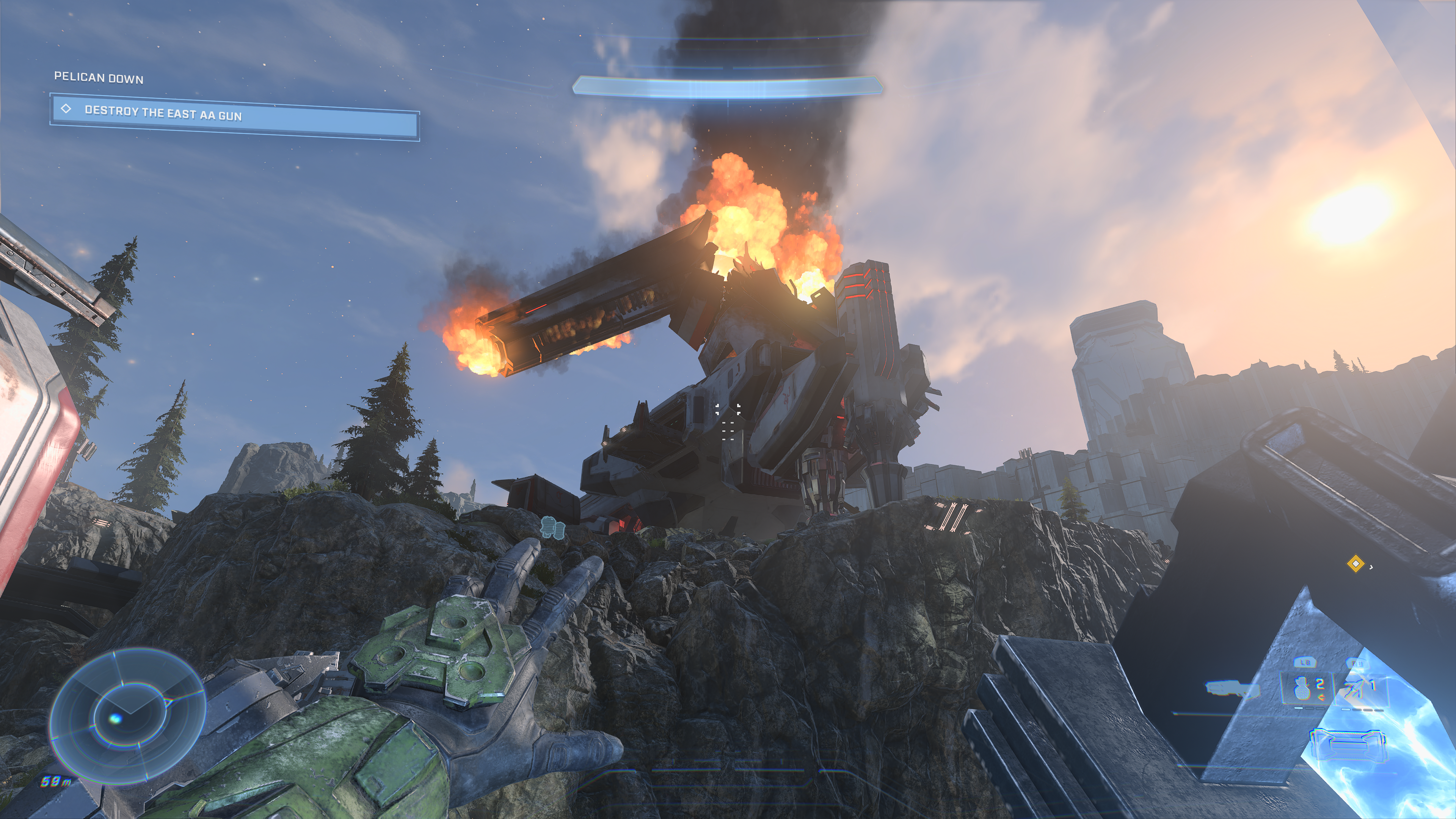 Blow stuff up real good.
Blow stuff up real good.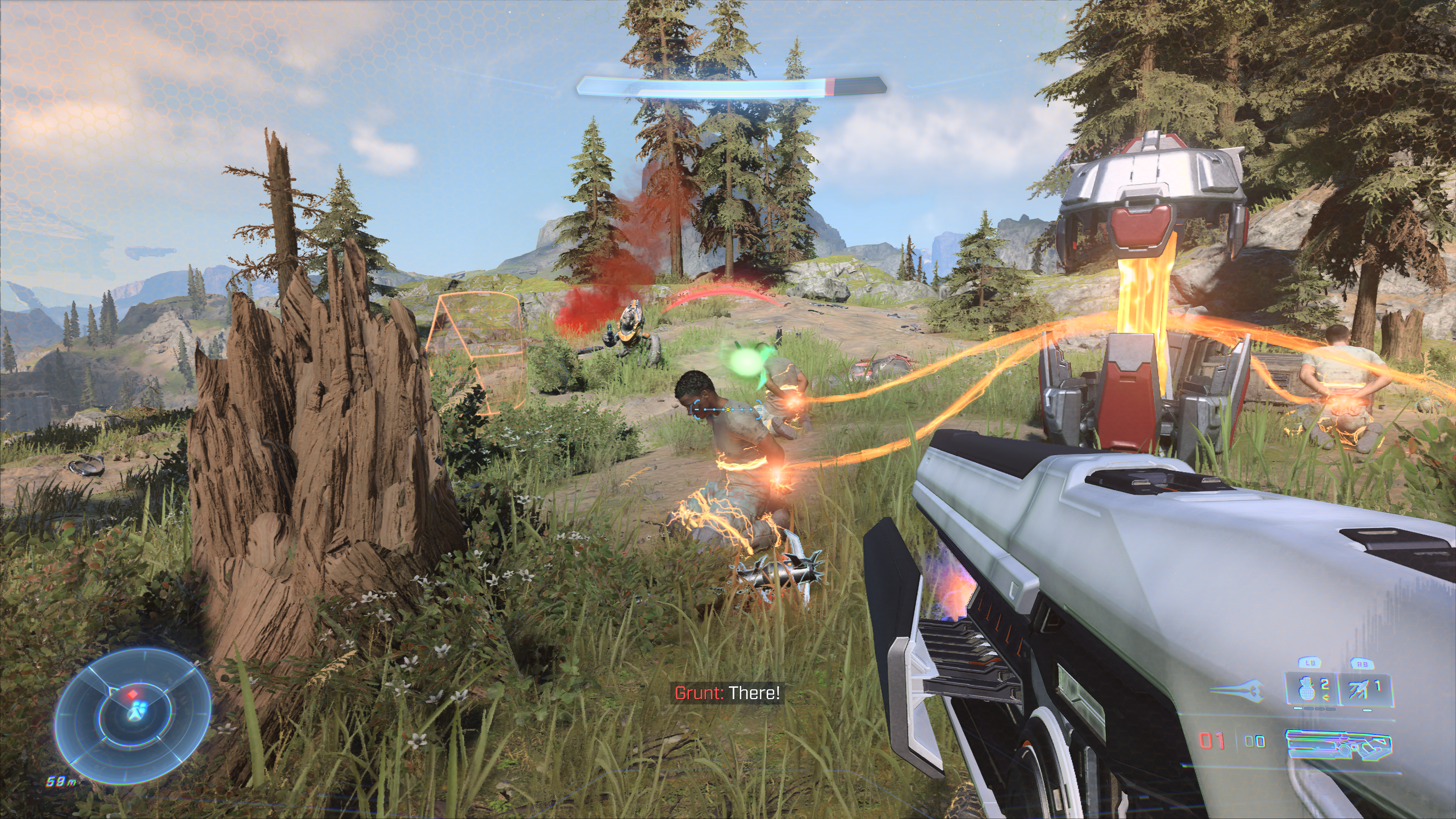 Save some imprisoned UNSC allies.
Save some imprisoned UNSC allies.
Most of Infinite's mechanics fall in line with the past 20 years of Halo first-person combat, and they generally feel more like Bungie's original vision, even if the weapon selection is a mix of the familiar and the brand-new. The bog-standard pistol and assault rifle, the ones Chief started with in Halo 1, have never felt snappier. Some of the military ("UNSC") weapons have been swapped out with punchier versions, particularly the shotgun, while a new scoped semi-automatic, the Commando, has quickly become a personal favorite. Classics like the rocket launcher and sniper rifle have been left untouched in terms of animation, reload speed, sound design, and damage potential.
343 gets a bit more ambitious with alien weaponry, particularly in the form of the Ravager, a supercharged update to the grenade launcher; the Skewer, a superpowerful and satisfying zoomed-scope blaster with lengthy reload times; and the Heatwave, an energy-powered shotgun whose blasts can fan out in either horizontal or vertical lines. But these weapons tone down the "look how weird we are" issues that plagued the arsenal in Halo 5 and feel more powerful, all boosted by solid sound design.
The same philosophy has gone into the abilities built into Master Chief's Spartan armor. Gone is the "melee dash" silliness that turned Chief into a Dragon Ball Z-like character in Halo 5. Instead, you can simply tap a "run" button to go faster, and you eventually unlock four suit abilities. The first, a grappling hook, will feel familiar to anyone who has played Apex Legends; it works much the same as that game's Pathfinder character. That's great news.
Hook onto any structure, wall, or ceiling in your range and the hook will reel Chief toward that point with a touch of up-and-over physics momentum so that he can either climb or fling himself forward in battle. It's a finicky system to learn at first, especially when you're trying to hook to the correct edge to climb a ceiling instead of bonking your head against it. But it ultimately proves fast, controllable, and rewarding. That's not even getting into the ability to hook nearby explosive barrels; you can grab them from afar to throw at foes or hook them directly into enemies or onto their vehicles. Doing either of the latter whips you in the enemy's direction. Zip yourself right at a foe to punch them in the face, or you can "grapplejack" an enemy's flying Banshee. This is always fun.
Do all the tasks, Chief!
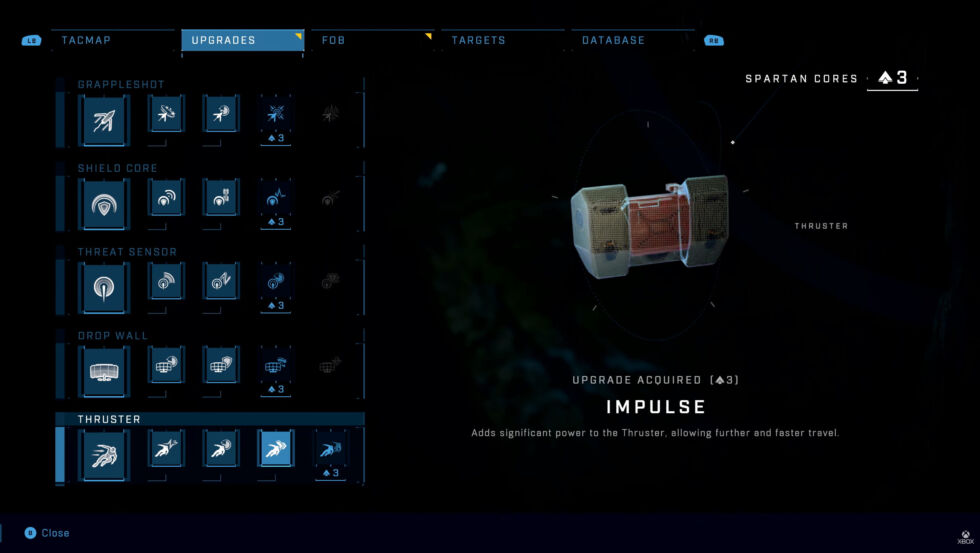
Infinite's other unlockable abilities include a radar beacon (launch it to expose hiding enemies in the distance), a dodge-dash, and a shield wall (you can shoot military bullets through these walls, while it will block aliens' energy bullets in both directions). Each has a small recharge, and each can be upgraded through the course of the campaign. These are all generally solid tools in Chief's combat arsenal, though they require tapping the d-pad to switch between them when you're using a controller. In the middle of a frantic firefight, this is way too unwieldy. 343, please consider adding a radial menu with a time slowdown to swap between abilities.
As my colleague Kyle Orland hinted at in his November hands-on preview, Infinite alternates between bespoke linear "levels" that resemble the indoor and underground missions of older games and a new, open-world environment. When Chief emerges from a pair of introductory missions to see the surface of Zeta Halo, his AI partner reveals a map, then immediately dots it with too many icons. Go here! Go there! Go to all the places and do all the tasks, Chief! The map makes the game look like it's filled with open-world busywork.
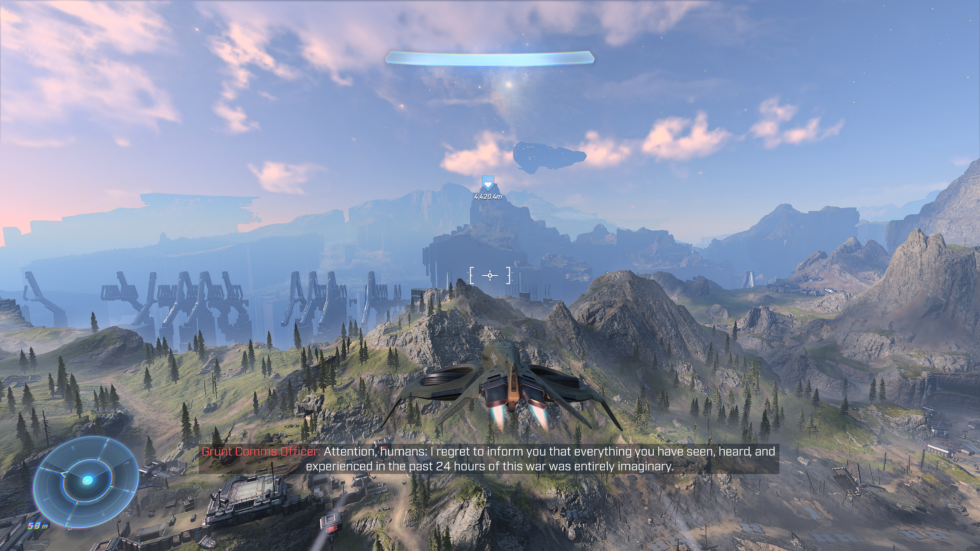
Thankfully, in practice, Infinite's open-world traversal doesn't necessitate using the map or connecting its dots. The map is fine for refining your marching or driving direction, but the best thing I can say about the game's visuals is that it's easy to look in Zeta Halo's distance, see a point of interest, head in that direction, and find a compelling encounter or battle. And truly, these are some of Infinite's best moments.
Many of the game's outdoor firefights and encounters play out like a love letter to Halo 1's classic "Halo" and "Silent Cartographer" maps. A couple of these experiences come from missions that follow the "wide linear" rule of keeping players squared on an objective, while many others emerge during the course of natural open-world gameplay. Still others have you prowling around the exterior of an enclosed, fortified base until you find a preferred point of entry (which you can create as you see fit, thanks to the new grappling hook). At that point, you enter the first line of defenses as you jump around an open-air mix of buildings, cover, and fields. Penetrate this first layer of a base to find further dynamic combat inside various buildings until you complete the objective of destroying said base.
Basically, 343 charts a few dozen encounters and terrain paths that would have been found in prior games' linear campaign levels, then spreads them over a series of floating, connected islands to make its open world. Additionally, 343 has a nifty tool in its toolbox: Halo's 20-year-long gimmick of warping enemies from outer space whenever needed. Infinite kicks serious butt in these moments. Follow your map to an icon or simply walk up to a weird-looking point of interest and the game will start inserting foes, all hunkered behind carefully crafted terrain that separates you from them. Surprise: it's a miniature level!
This isn’t an MMO, mostly for the better
But these moments prove more interesting than the loot they dole out. Infinite may very well prove to be a speedrunning bonanza, as you don't have to leave the beaten path to get everything you need to soup up Chief's abilities. You can't increase your "power" or "ammo" stats by beating quests. The most useful "points" in the game are so abundant that you'll have your "armor" rating maxed out within four hours of play. And this isn't like an MMO, where later enemies have artificially higher stats. You're surviving largely by salvaging whatever guns and ammo are on the ground, whether you've beaten every side quest or none at all.
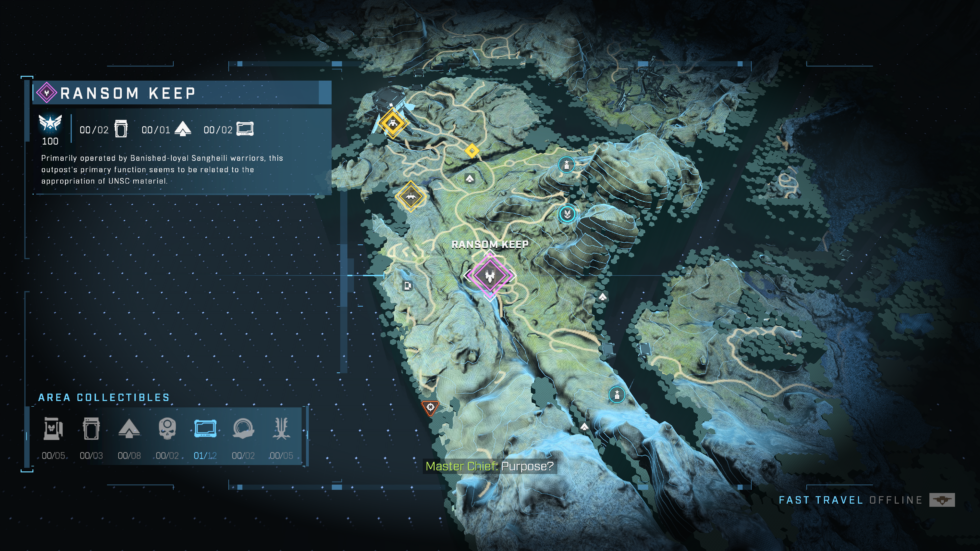
Other sidequest unlockables let you generate certain weapon and vehicle types at bases, but since these are limited—by guns' fixed ammo amounts and vehicles' struggles to clear obstacles—they're rarely worth the trouble to equip. It's nice to have a fast-reloading variant of the pistol, for example, which you'll eventually claim for your arsenal by killing a "miniboss" stationed somewhere in the open world. But if you equip it for yourself, its usefulness runs out quickly. Missions in Infinite don't usually get tough until you run out of your equipped weapon's ammo and have to scramble, and miniboss weapons typically can't be reloaded with other guns' ammo. Even then, the guns you find scattered on the ground are already tuned to feel powerful and take out a ton of foes.
Infinite made the right call here. I'd rather chase down side quests and tucked-away corners of the map because the combat and level design are fun, not because it will make a number tick upward. But there was a sensible solution 343 could have used: Why not tie some of the series' "skull" unlockables to these side quests? These skulls unlock cosmetic tweaks or compelling challenge modifiers, and prior games hid these features in corners of levels. Infinite does the same with its own skull selection. That's a fine carrot-dangle for fun secrets, but earning skulls by beating side quests seems more fun to me. I wish Infinite's devs agreed with me.
Not the nicest sidequest houseguest
One of my favorite sidequest moments came when I chased down a beeping beacon at the edge of a cliff. I looked down and saw footholds many stories below me. I had already used my grappling hook to go up and down similar cliffsides before, so I jumped down. At the very bottom, I saw my prize—inside a fortified cave carved into the cliff, with a deadly sniper facing away from me and talking to one of his buddies.
Once I had played the part of rude houseguest and killed all the inhabitants, I walked through the rest of the cave, only to realize it spat me out into a wide-open field that I could have reached via a more pedestrian path. Huh. 343 made a wacky "fall from great heights to stumble upon a cave" entrance when the front door was right here? So it's not necessarily likely that everyone will find the cave this way? That's pretty cool. Halo Infinite dots its world with a noticeable number of these moments.
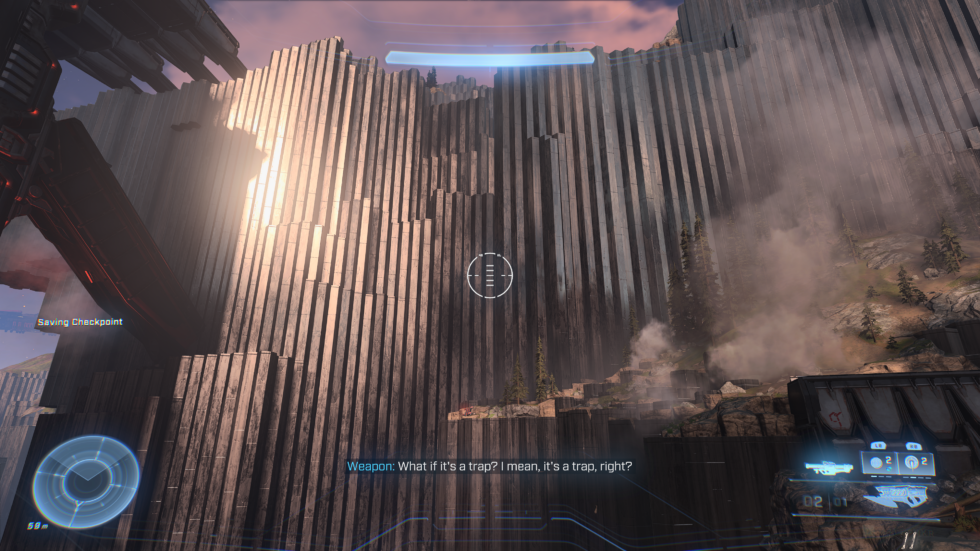
But I don't want you walking away from this review believing that 343's open-world landscape is always this dense. Really, it's tragic how many dead-ends and red herrings show up across Zeta Halo and how often I trudged to a seemingly interesting corner of the map only to discover very little. This becomes starkly apparent once the campaign is over—which took me 13 hours on the "normal" difficulty, and that was arguably at a leisurely, exploratory pace.
The game's open-world portion makes up half of that completion time, as it includes a number of required quests (activate that beacon, blow up that alien outpost) and obvious sidequest paths to a few easy, useful upgrades. That's only five to six hours, which matches Zeta Halo's underwhelming size and scope. Compared to prior Halo games' biggest open-world levels, of course, that's a sizable jump, but it's nothing compared to the enormity of other modern open-world rivals.
Less bloat—but also, far less visual diversity
343 can easily retort by pointing to how little bloat and repetition are found in its open-world concept. If you're looking for the tight gameplay core of Halo mixed with both more open boundaries and a visible finish line—as opposed to the seemingly endless sidequest slog found in many open-world games—you'll appreciate this design philosophy.
But I'd answer by saying that games like Assassin's Creed Valhalla and Grand Theft Auto V at least built diversity into their oversized worlds. Rockstar Games in particular has proven how to make a massive virtual world feel wildly different from one end of a map to the other, and the company has done so on the same dated Xbox One hardware that Halo Infinite is tethered to. 343 has zero excuses for delivering a Halo game whose open world looks dreadfully boring from corner to corner.
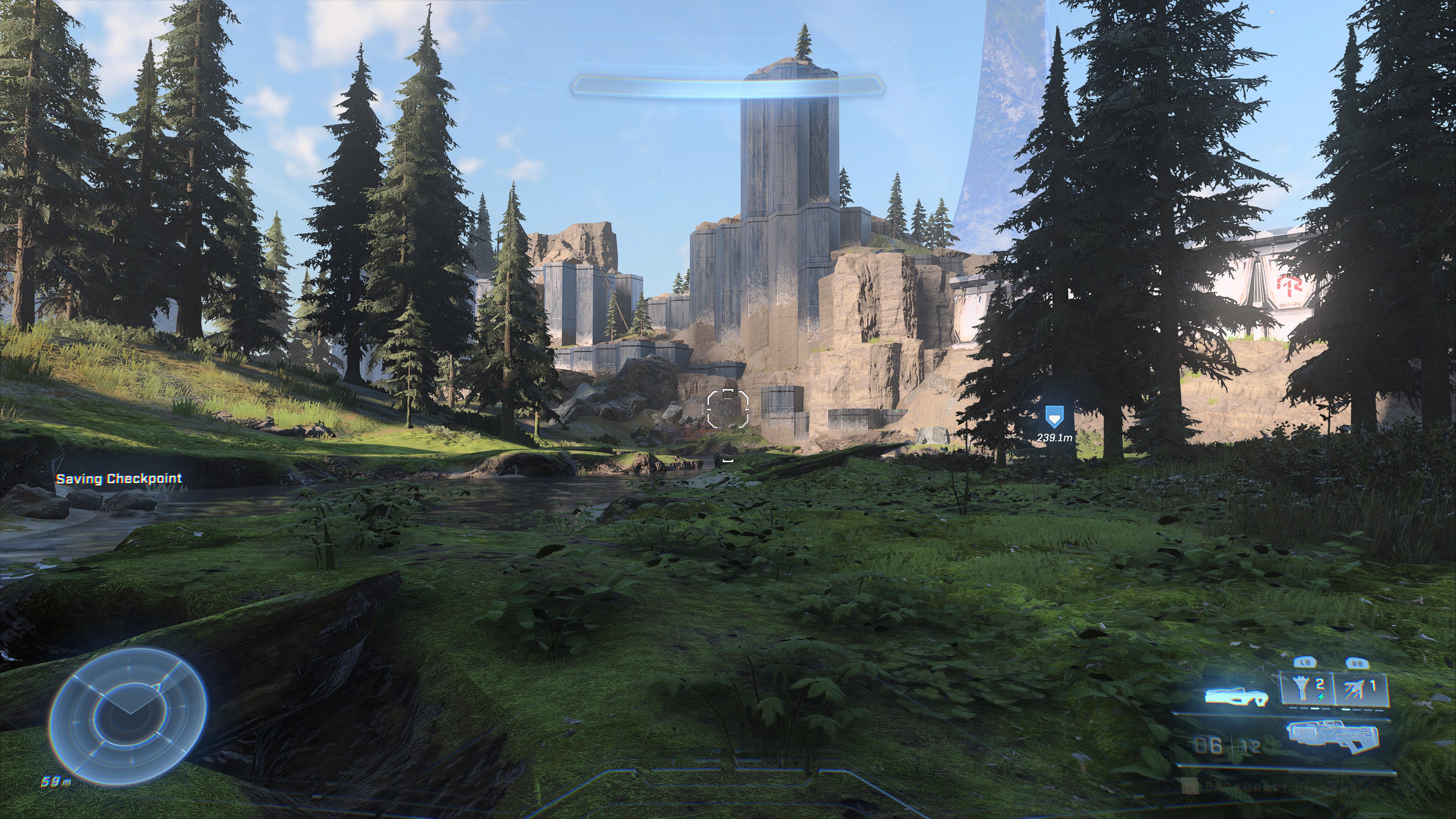 Infinite's terrain is either tree-lined grasslands...Xbox Game Studios / 343 Industries
Infinite's terrain is either tree-lined grasslands...Xbox Game Studios / 343 Industries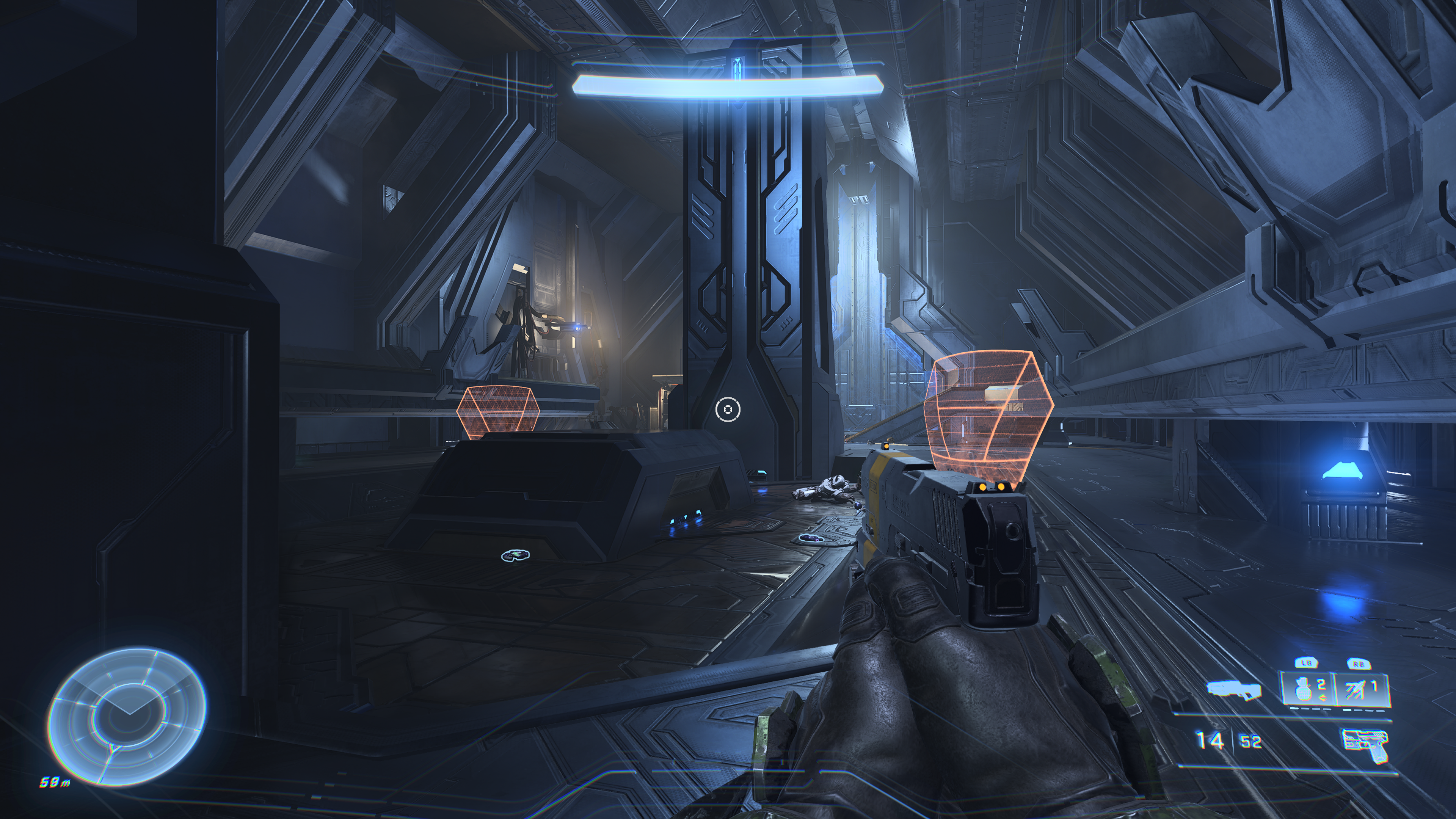 ...or repetitive blue-neon interiors...
...or repetitive blue-neon interiors...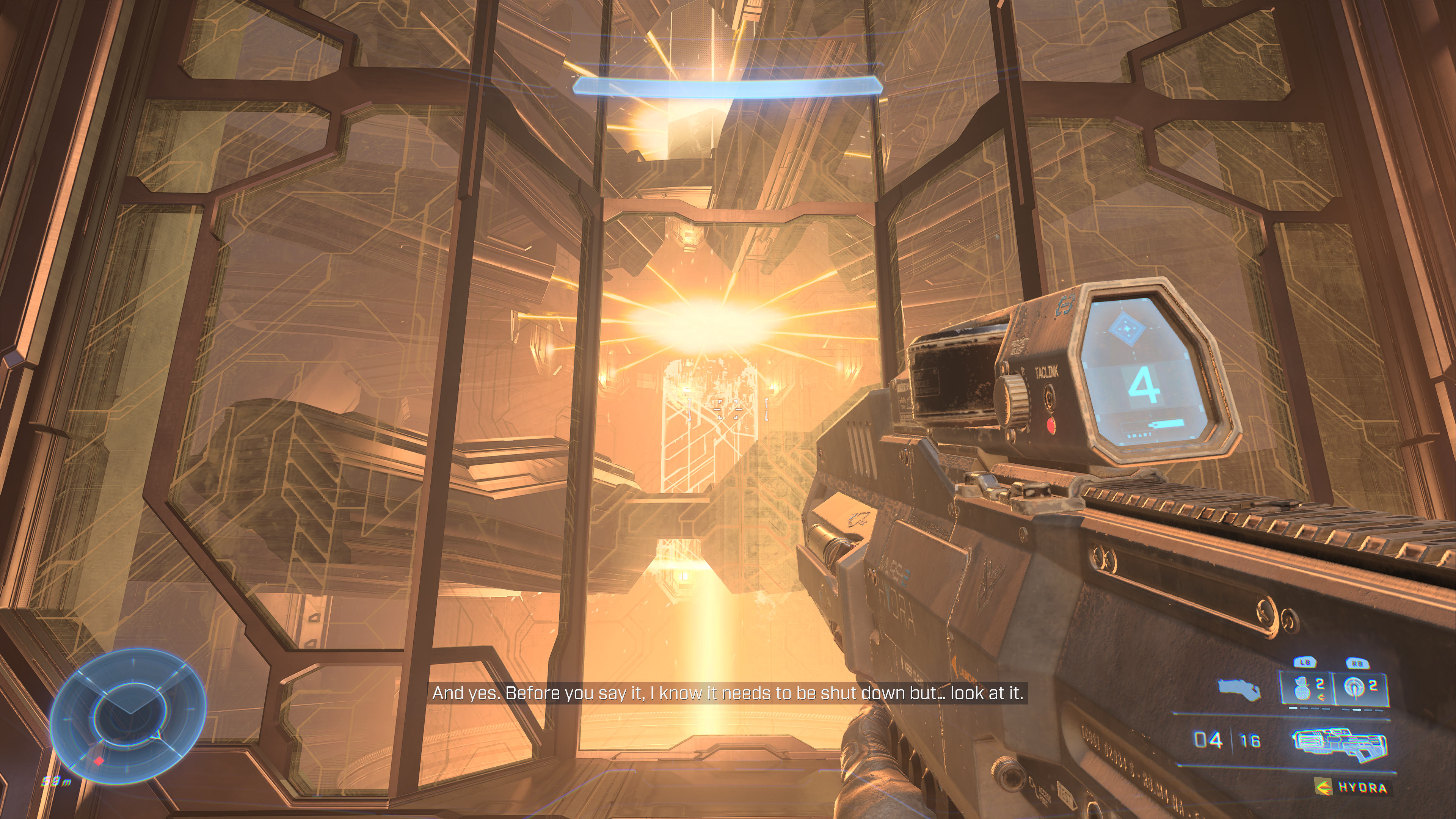 ...or occasional glimpses at fantastical sci-fi weirdness...
...or occasional glimpses at fantastical sci-fi weirdness...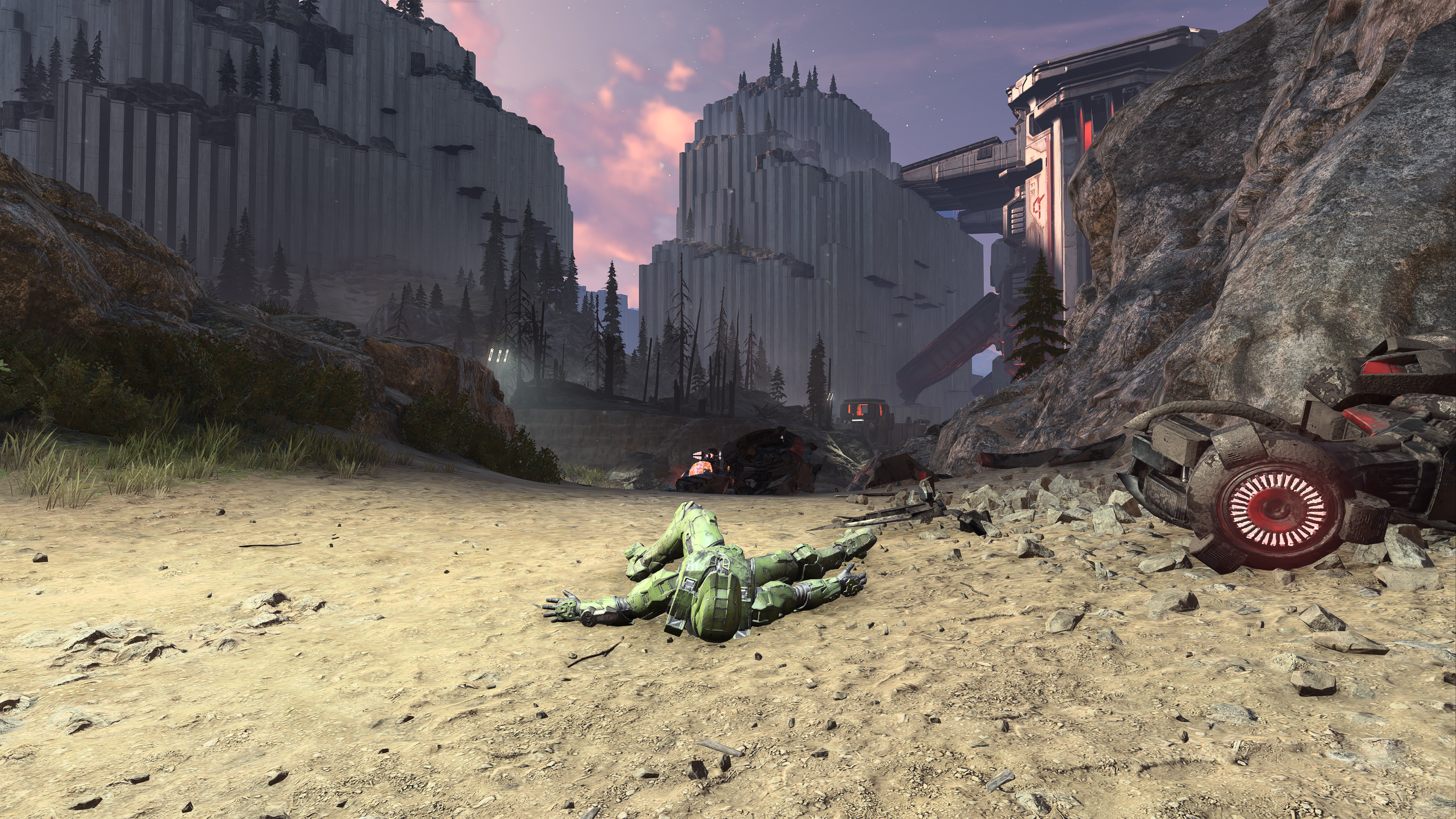 ...or dry dirt between hexagonal, metal structures.
...or dry dirt between hexagonal, metal structures.
Infinite's preview video footage has thus far revolved around a mix of grasslands and metal, hexagonal structures. I wondered ahead of my time with the game whether we'd get a single other biome in Infinite's overworld, and the answer is a resounding "no." This stands in stark comparison to Halo Infinite's original CGI reveal in 2018, which hinted at serious biome diversity that will apparently never come to pass.
Up close, at least, the final game's structures look fetching and otherworldly on the Xbox Series X. Their shiny, texture-rich metals stand in sharp contrast to the dirt, grass, and rocks that emerge alongside them. But too often in Infinite, the world looks like this:
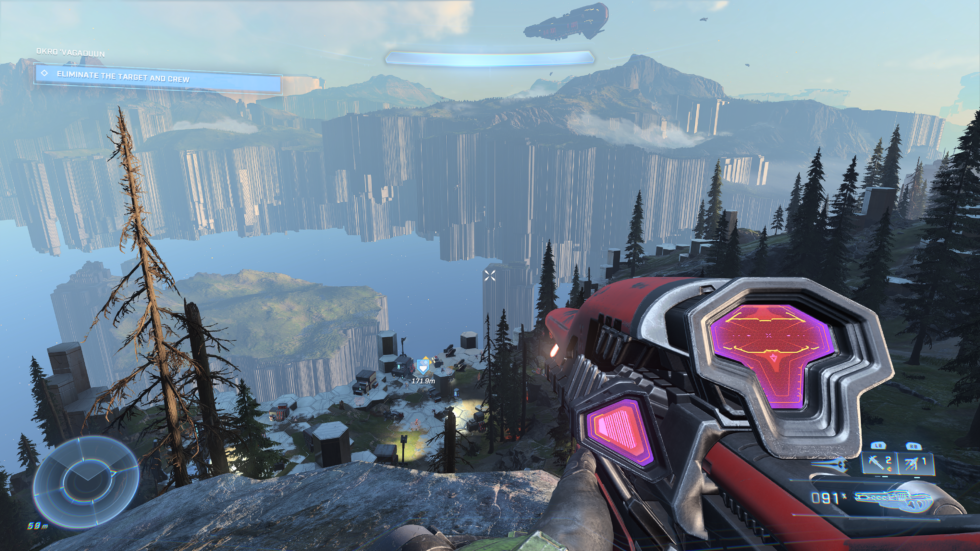
Those floating bits in the horizon are supposed to be additional chunks of the broken Zeta Halo, but something is seriously wrong with how 343 has chosen to reduce distant details. They're in desperate need of another pass or two: updated materials, updated lighting, updated shadows—anything.
The game engine further reveals its visual weaknesses when close-up details block your view of the horizon. Object pop-in and "level of detail" changes are constant issues, with rocks and grass appearing, vanishing, or morphing while you're scanning the battlefield for foes. This happens even on the Xbox Series X's "quality" 60 fps graphics mode, as opposed to the "performance" mode, which trades visual detail for an overkill 120 fps refresh rate. And whenever the game's time-of-day system triggers a change in lighting, it generates a freakish flash of uneven lighting levels on all nearby surfaces.
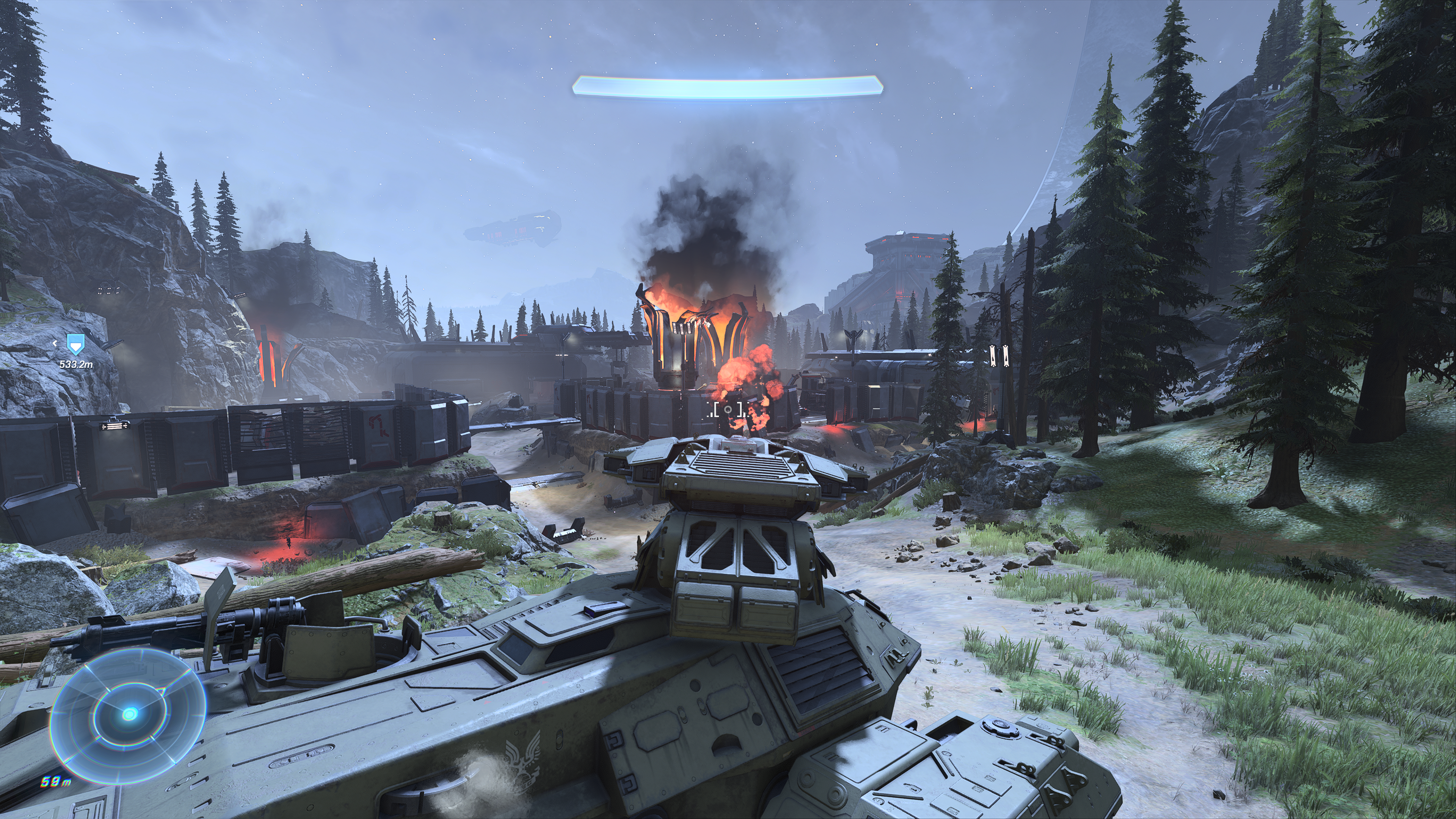 At their best, Infinite's Scorpion tanks romp through strongholds and blow stuff up. But...
At their best, Infinite's Scorpion tanks romp through strongholds and blow stuff up. But...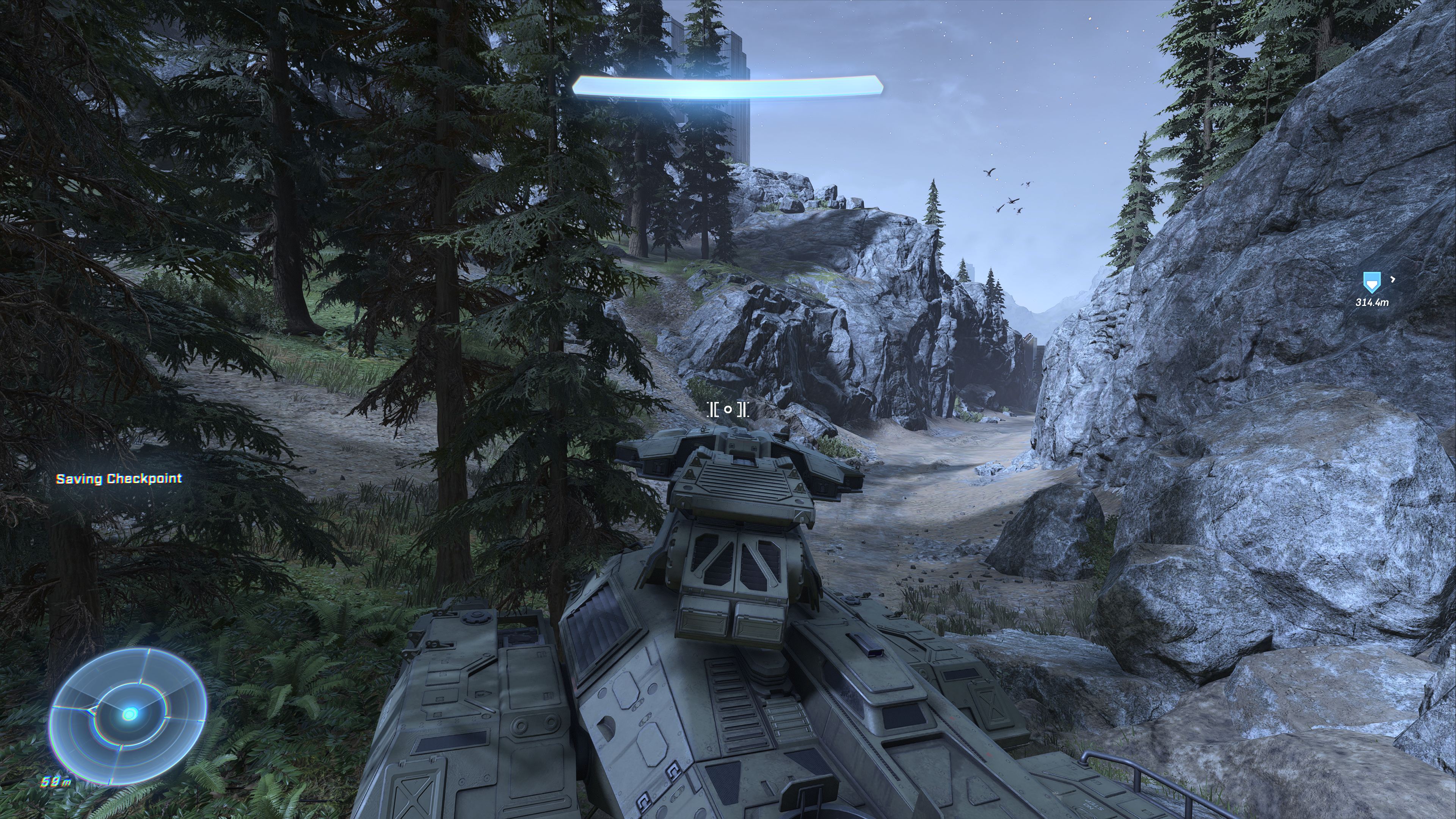 ...at their worst, Infinite's Scorpion tanks get stuck behind a single freakin' tree. Yikes.
...at their worst, Infinite's Scorpion tanks get stuck behind a single freakin' tree. Yikes.
One "technical" issue proved quite surprising: the game's foliage gets in the way of satisfying vehicular traversal. Commandeer a Warthog four-wheeler or a Scorpion tank, and you might expect to rev your engines to full blast and tear through whatever shrubs, rocks, or trees stand in your way, much like how an average sedan can blow through small trees in Forza Horizon 5. That's not the case. Infinite's foliage appears to be made out of the same concrete that lines the edges of Zeta Halo, and it will stop any vehicle dead in its tracks. This renders the Scorpion practically unusable in much of the open world, since the game's network of clear roads is pretty minuscule. I understand that 343 wants to restrict vehicle access to certain encampments and battles, but the decision kills the feeling of true driving freedom.
A Warthog-sized warning about Infinite's PC version
Indoor levels, meanwhile, are designed with a measly selection of materials and architectural choices. If you like blue neon accents, criss-crossing metal patterns in walls, and curved surfaces everywhere, you'll feel right at home in Halo Infinite's repetitive underground levels. As I look back at my time tearing through the campaign, I can recall only a few truly visually striking interiors, and only one of those—in an intimidating spire—wasn't eventually copied and pasted into another level or three. (Related: the game's final, climactic boss battles are staged in particularly unappealing arenas. One is a painfully cramped and generic pair of rooms and tunnels, while the other is a barren, oversized hall. They reek of makeup content that was created after an initial idea didn't work out.)
Whether you battle enemies inside these underground structures or out in the open world, they suffer from a lighting system that remains as unpredictable, uneven, and ungrounded as we saw in the game's underwhelming 2020 reveal. And the closer you look at Infinite, the worse it gets, especially when the frame rate bounces all over the place. On the Series X, the game delivers steady performance where it counts, including an apparently locked 60 fps in "quality" graphics mode for aiming, running, driving, and flight.
But what about PC, you might ask? We're left asking that question, too. Despite our repeated requests, Xbox reps denied us access to the game's PC build on either the Windows Store or Steam ahead of this week's embargo lift, even though the company's review guide includes instructions for how to access the game's pre-release PC build. Based on the Xbox team's unwillingness to budge on this point, we're sounding the alarm about Infinite's PC version until further notice—especially since that leaves us unable to test performance across various PC specs. (We're also left wondering how the PC version's ultra-widescreen support will play out in both standard gameplay and cinematic cut scenes.)
Good news for Chief and his AI, bad news for everyone else
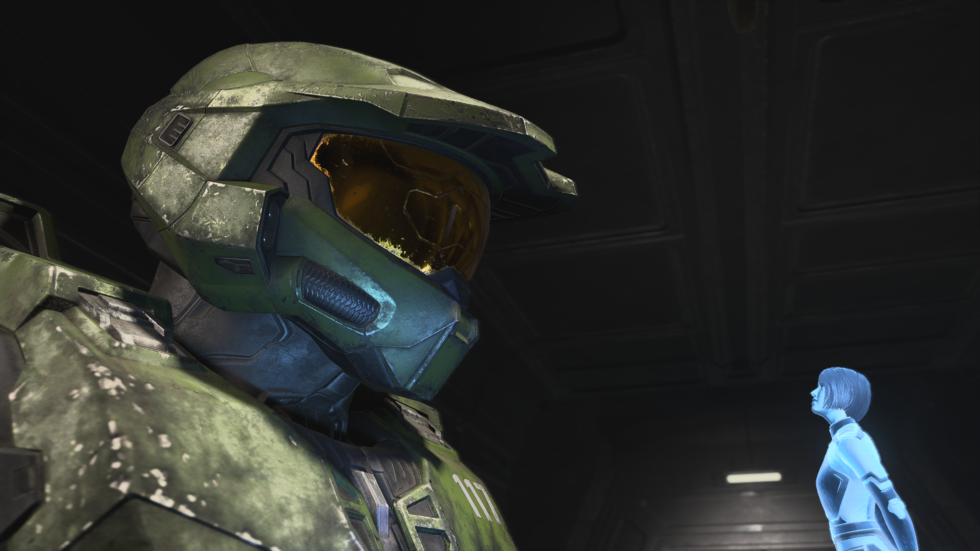
The best-looking moments in the game come when the camera gets outside of Master Chief's helmet to frame him and his new AI partner, dubbed "The Weapon," in cut-scene conversations. These moments are enhanced by tight, thoughtful cinematography, trippy 3D visions, and incredible detail on the characters' models and animations—particularly the Weapon's real-time animated face. Rarely have an in-game actor's expressions and performance moved me to such an extent and overcome the uncanny valley of facial animation. To whoever put together the Weapon's digital performance: bravo.
Halo 4 anchored its campaign in the compelling and ever-changing relationship between Chief and his original AI pal Cortana to great effect, and Infinite uses the Weapon to refresh this storytelling device. Their story is doled out in both cut scenes and in-ear, mid-mission chatter, and the Weapon takes advantage of being a newly revealed character to emerge with a macabre enthusiasm—always able to find laughs and jokes while facing deadly encounters.

This works largely because Chief's longtime voice actor, Steve Downes, responds coolly to Weapon's more lively performance. Chief speaks more in this game than any other Halo entry, but Infinite's writers are careful about maintaining his stoicism via terse replies (or, sometimes, none at all) yet let him off his leash when it adds dramatic or humorous effect. I only cringed twice thanks to a seemingly out-of-character Chief line. Considering how much more he talks in this game, that's a relief.
The same cannot be said for Infinite's other major voice actors. "The Pilot" has previously appeared in the game's trailers, and bizarrely, most of that character's compelling cut scenes in the final game are the ones we've already seen on YouTube. Otherwise, he's a stripped-down, helpless damsel who moves the plot forward by either helping Chief get to his next mission or finding himself in trouble. Midway through the game, we hear the Pilot's entire character arc in a single chatter session. This seems to suggest that the Pilot originally figured in the script in a bigger or different way but was rewritten late in production. If that's what it took to get us such a solid Chief-and-Weapon repartee, I'll take it, but when the plot demands that the audience sympathize with the Pilot, it's difficult to do so.
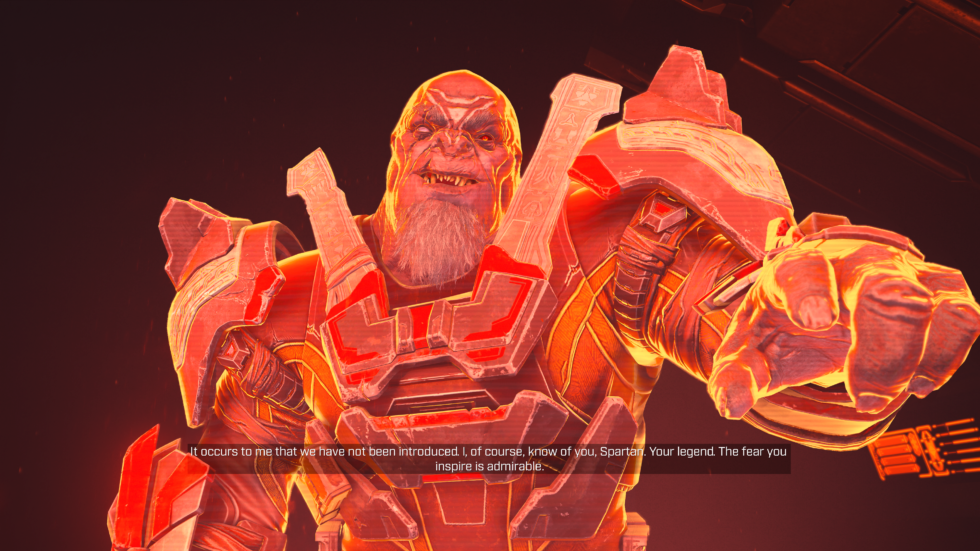
Much worse is the game's main villain, a hairy, shouting brute-like creature named Escharum, who drags the story to a halt whenever he appears. Escharum primarily shouts about what a great rival Chief seems to be and why he's thus sparing Chief's life for now in spite of having eyes on Chief's progress at all times, then brags about the various victories he and his race, the Banished, have had over the UNSC. In monologue after monologue, this character neither elicits sympathy nor engenders terror in any way. Imagine a WWE wrestler never getting into a bout and spending a year of his career showing up to matches, shouting in a video cutaway, and then vanishing. Then imagine a story trying to redeem this character for no logical reason. That's Escharum. Woof.
Call it a “cliffunhanger”
Thankfully, Chief and the Weapon are left alone to uncover plenty of revelations about the threat of Zeta Halo, the machinations behind Cortana's disappearance, and the greater quest they must face. The voice actors' solid performances give the game enough weight, purpose, and voice to make the plot worth investing in. Plus, if you want to do the usual Halo "extended universe" thing and get some extra storytelling on the side, Infinite's dozens of hidden "voice memos" tell more tales that star unseen characters and prove compelling in their own right.
I won't reveal how the game ends, but I'll say it somewhat resembles the ending of Halo 2, as it leaves players hanging while listening to the heroes talking about "finishing the fight." Yet shortly after this ending scene fades to black, players warp back to the game's open-world island, at which point Master Chief says, 'We're here to finish the fight." This is confusing in part because the ending seems to set up an entirely new conflict and destination, but 343 simply wants you to sweep up loose ends, lest you accuse the devs of only making a 13-hour video game. So players get to finish the re-finishing. Call it a "cliffunhanger," maybe.
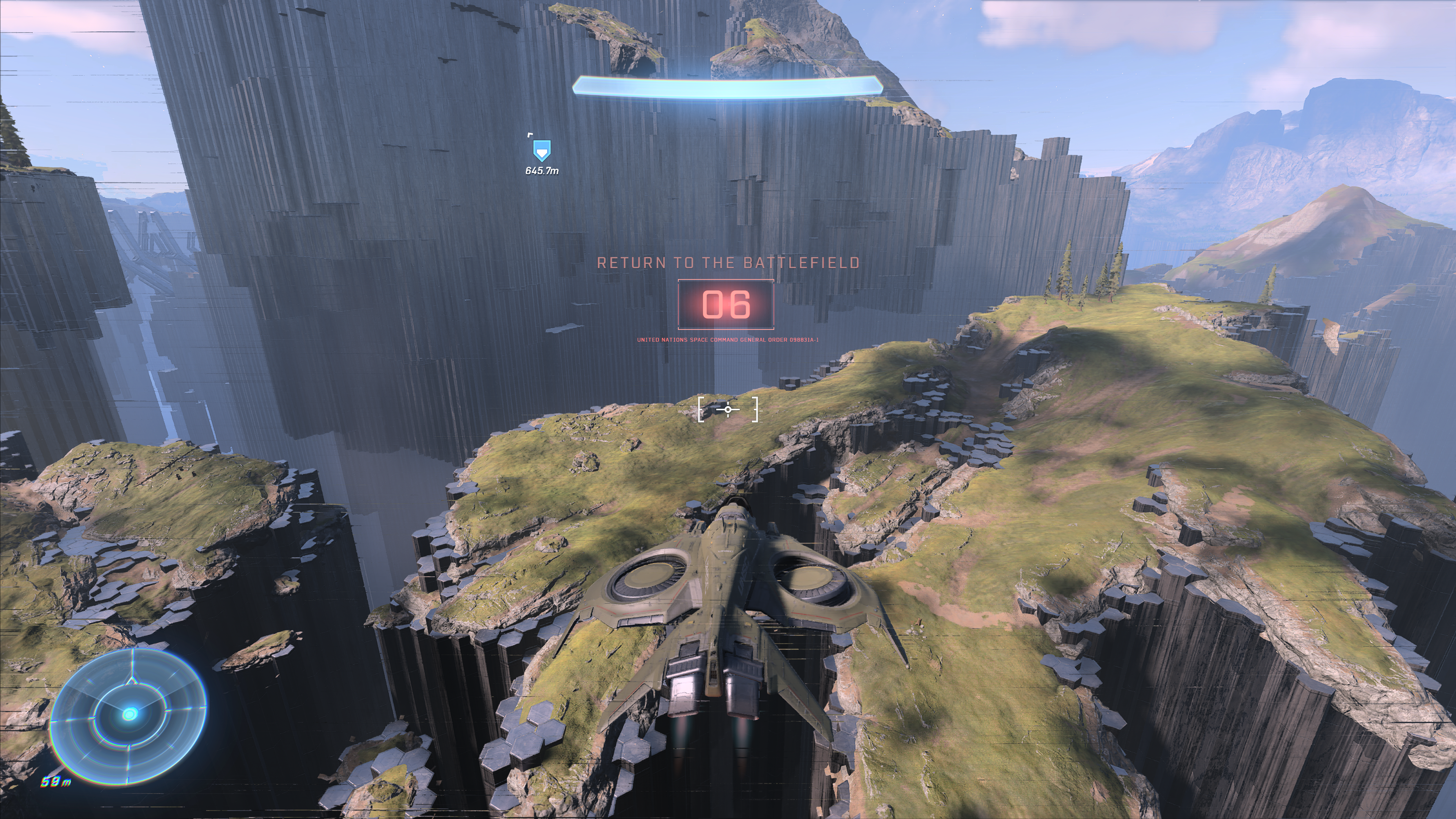 Invisible, restrictive barriers in Halo Infinite's open world are a reminder that it's not so "infinite" after all.
Invisible, restrictive barriers in Halo Infinite's open world are a reminder that it's not so "infinite" after all.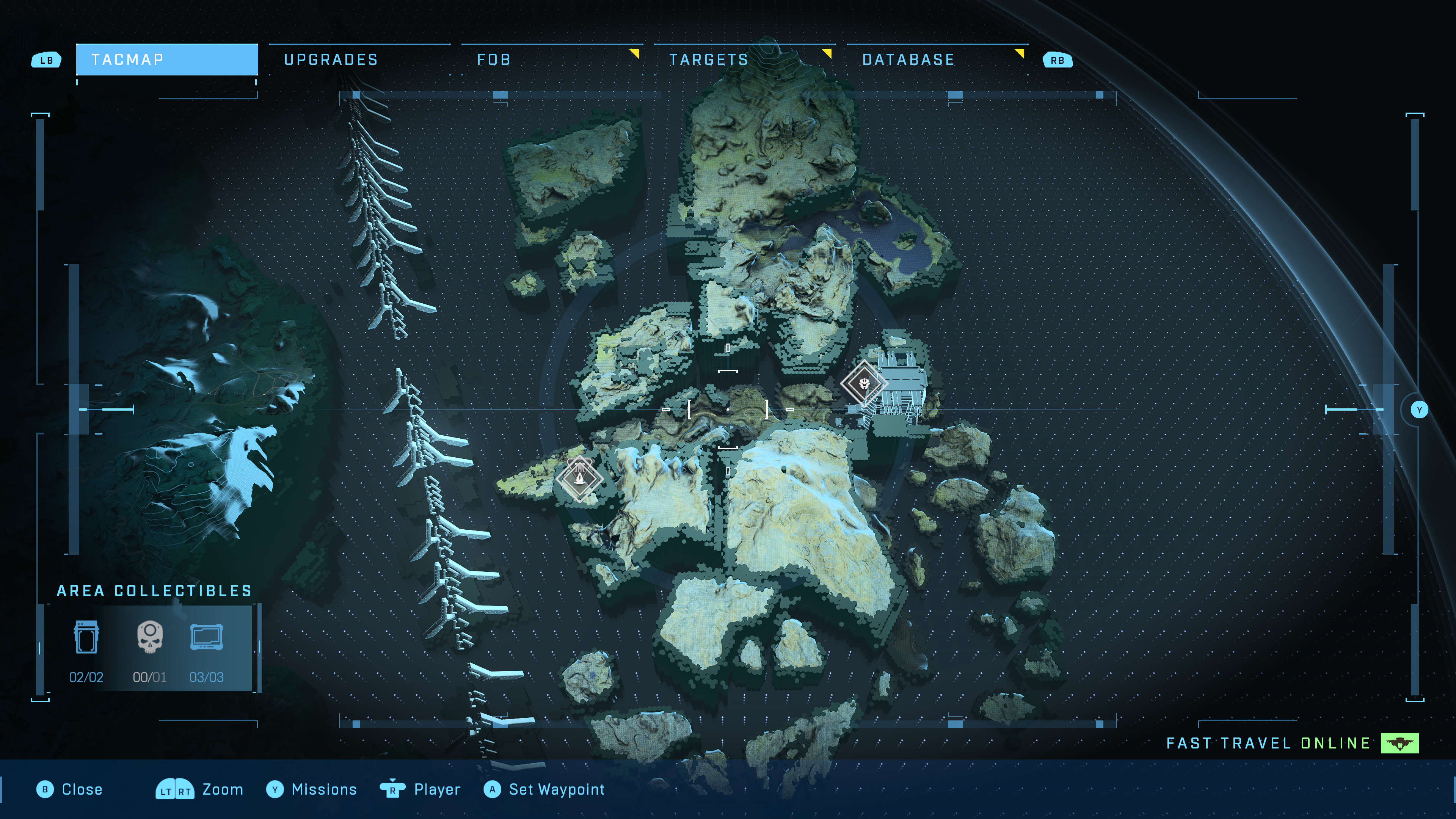 That's roughly one third of the game's visible open-world content in the map. And players can't actually go to any of it.
That's roughly one third of the game's visible open-world content in the map. And players can't actually go to any of it.
At this point, I began exploring as many corners of Infinite's map as I could, only to run into an unfortunate "invisible" wall applied to roughly one-third of its map. A huge landmass sits in Zeta Halo's northeast corner, visible in the pause menu's map, yet Infinite will sternly demand that players "return to the battlefield" should they commandeer a flying craft and head in its direction. Did this location originally host content that was deleted at the last minute? Is it a tease of upcoming DLC, to be unlocked at a later date? It's unclear. 343 has previously described a plan for "a decade" of content in Halo Infinite, though that announcement came before the game's surprise delay from 2020 to 2021.
Bottom line: The right start for Halo's future... someday
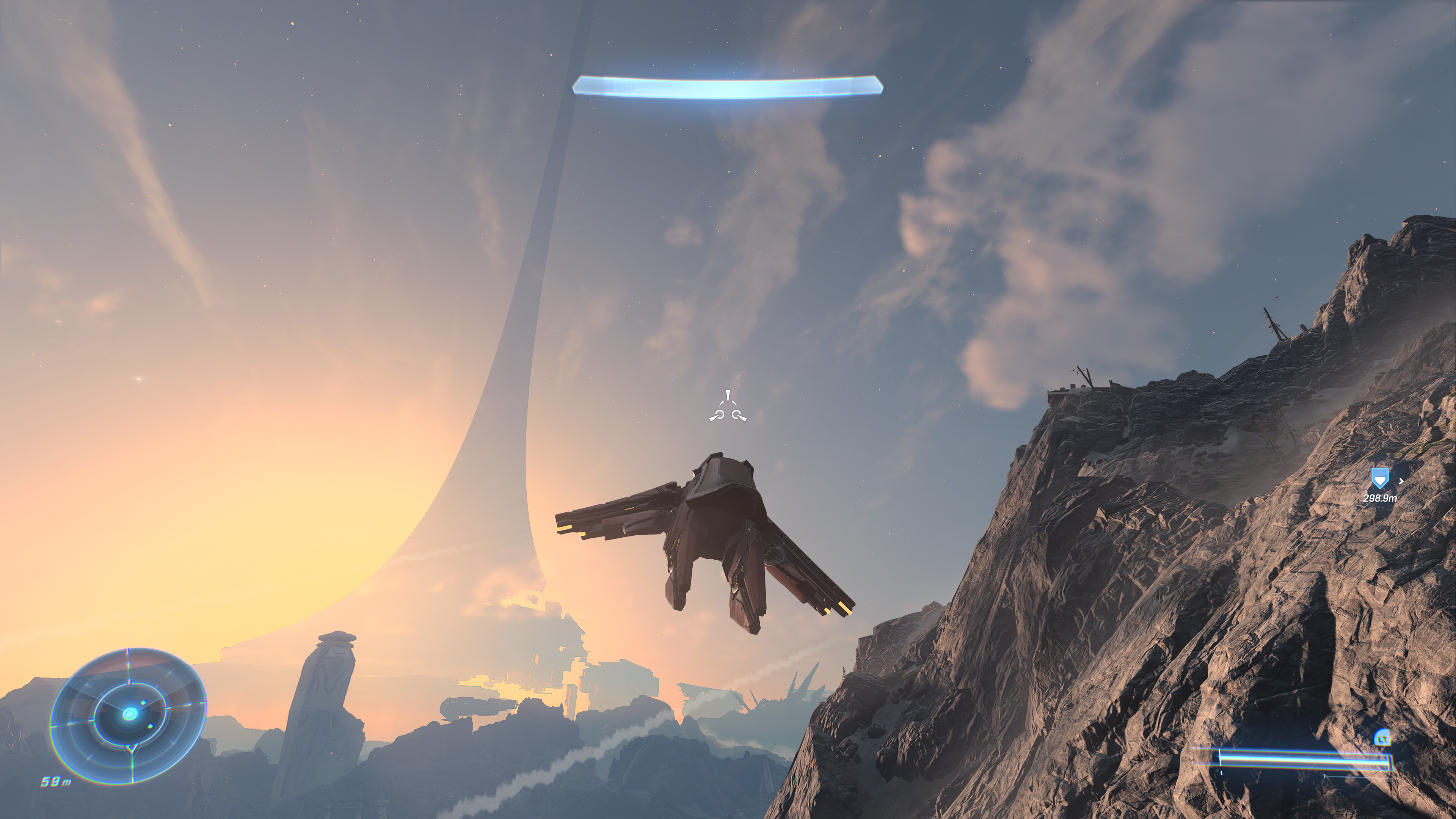 The beauty and potential of Halo Infinite, when posed at the most cinematic angle.Xbox Game Studios / 343 Industries
The beauty and potential of Halo Infinite, when posed at the most cinematic angle.Xbox Game Studios / 343 Industries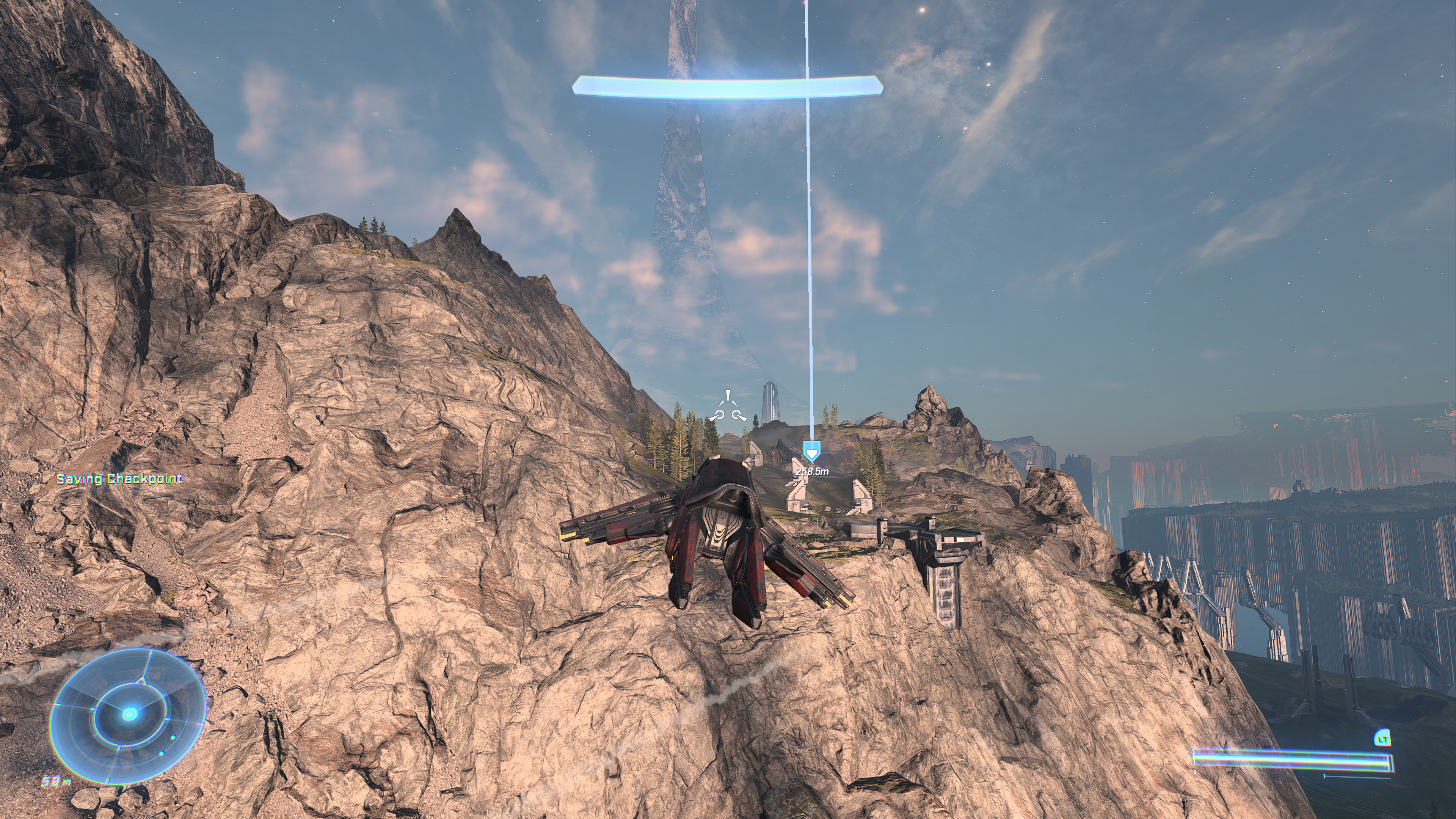 Then, the reality of turning 180 degrees from the previous photo's direction and looking at the ugliness the other way.Xbox Game Studios / 343 Industries
Then, the reality of turning 180 degrees from the previous photo's direction and looking at the ugliness the other way.Xbox Game Studios / 343 Industries
At this point, I'd love for 343 to backtrack on that original promise and announce Halo 7, Halo More Infinite-er, or some other entirely new game. Because despite how broken and rushed this title appears at times, it nails the foundation that I'd love to see 343 return to—with all the last-gen hardware shackles released.
Somehow, Infinite proves that the Halo series still has the capacity to astound and surprise. I found myself losing late-night hours to the campaign because I was caught up in an urge to explore or because I got sucked into one of the 90-minute mission chains marked by epic firefights, solid bosses, and chemistry-filled cut scenes. I loved seeing the series' tried-and-true mechanics applied to emergent, open-world mission discovery. I found myself compelled to finish side quests not because of an experience-point promise but because I expected (and usually found) a fun firefight in each.
If you gave me more of this—larger worlds, more biome diversity, more enemy types, better ground vehicle traversal, co-op integration, and the bread-and-butter Halo-ness that this game generally understands—I'd be set. Until then, I'll comfort myself with the parts of Halo Infinite I genuinely enjoyed, along with the post-campaign whimsy of combing the game's unseemly, low-detail edges in search of fun combat and reasons to zip around with this spiffy new grappling hook.
The good
- The series' modern handlers at 343 Industries have finally nailed a balance between reverence for classic Halo mechanics and smart ideas to push the game into new adventuring heights
- Open-world level design resembles and expands upon the best ideas in the original trilogy's "wide linear" outdoor zones
- Grappling hook adds speed, precision, exploration, and fun to Master Chief's core ability suite without feeling as gimmicky or annoying as other games' experiments
- Master Chief and his new AI assistant shine in their vocal performances, and they breathe life into a compelling, intrigue-filled story
- That inimitable feeling of leaping over a massive hill on a Warthog four-wheeler, then landing with Halo's classic bounciness
The bad
- That awful feeling of steering a four-wheeler or tank into a tiny tree and having your movement screech to a halt
- The new Zeta Halo open-world environment is alarmingly tiny, which makes its lack of biome diversity even harder to comprehend
- Indoor levels occasionally recall the glory days of Halos past but generally lean too hard on underwhelming, copy-and-pasted architecture
- At least as of launch, enemy AI leaves a bit to be desired—this issue is forgivable for reasons stated in the review, but it's compounded by the fact that 343 relies almost entirely on recycled enemies from past Halo games
- Ammunition availability is tuned badly compared to the best classic Halo games
- Many boss encounters turn into frantic, uncreative rushes, and they're often staged in forgettable, cramped, and generic-looking arenas
- Characters who aren't either Master Chief or an AI companion are generally bad across the board, especially when it comes to Infinite's most prominent rival
The ugly
- This game. For all of Halo 5's faults, that 2015 game looks drastically better, and it didn't even have the benefit of powerful platforms like PC or the Series X
- Co-op campaign functionality has been delayed until further notice (current estimate: May 2022)
- Xbox Game Studios repeatedly declined to provide Ars Technica access to Infinite's PC version ahead of today's review embargo, which we consider a serious red flag
Verdict: Halo Infinite's campaign sets the stage for an incredible sequel someday. Today is not that day. Consider this a fine rental or excuse to burn through a single month of Xbox Game Pass, either now or whenever the co-op mode finally goes live in 2022.
https://ift.tt/3xX1z7v
Technology

No comments:
Post a Comment